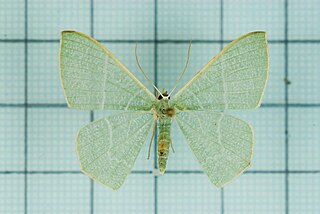
The blue-winged leafbird is a species of leafbird found in forest and second growth throughout Southeast Asia as far east as Borneo and as far south as southern Sumatra. It previously included Jerdon's leafbird from the Indian Subcontinent, and the Bornean leafbird from northern Borneo as subspecies, but differs from both in measurements and morphology, with Jerdon's lacking any blue to the flight feathers, and Bornean having a distinctive male-like female plumage. The Javan leafbird, which is endemic to Java, was also formerly grouped with the species, but more recent phylogenetic studies have split both. The distribution of the blue-winged and the Bornean leafbird are known to approach each other, but there is no evidence of intergradation.

The golden-fronted leafbird is a species of leafbird. It is found from the Indian subcontinent and south-western China, to south-east Asia and Sumatra.

The orange-bellied leafbird is a bird native to the central and eastern Himalayas, Yunnan and northern parts of Southeast Asia. The greyish-crowned leafbird, which is found in Hainan, is again considered conspecific. The scientific name commemorates the English naturalist Thomas Hardwicke.

Jerdon's leafbird is a species of leafbird found in forest and woodland in India and Sri Lanka. Its name honours Thomas C. Jerdon. It has traditionally been considered a subspecies of the blue-winged leafbird, but differ in measurements and morphology, it lacking the blue flight feathers for which the blue-winged leafbird was named.

The Philippine leafbird is a species of bird in the family Chloropseidae. It is endemic to the Philippines. It is found in the islands of Mindanao, Leyte, Samar and Cebu. Its natural habitat is tropical moist lowland forest. It is threatened by habitat loss.

The Bornean leafbird, also known as the Kinabalu leafbird, is a species of bird in the family Chloropseidae. It is found in humid forest in Borneo, to which it is endemic. It has traditionally been considered a subspecies of the blue-winged leafbird, but differ in measurements and morphology, the female Bornean leafbird having a distinctive male-like plumage. The distribution of the two are known to approach each other, but there is no evidence of intergradation.

The Sumatran leafbird is a species of bird in the family Chloropseidae. It is endemic to forest and plantations in Sumatra in Indonesia. It has often been included as a subspecies of the golden-fronted leafbird, but the two differ extensively in, among others, morphology, with the male of the Sumatran leafbird having a yellow forehead, and the female resembling a female blue-winged leafbird, but with a yellowish forecrown and no blue to the wings and tail.

The greater green leafbird is a species of bird in the family Chloropseidae. It is distinguished from the lesser green leafbird by its powerful beak, yellow throat and eye ring of the female; and lack of a yellow border along the black throat patch found in the male C. cyanopogan.

Thalassodes is a genus of moths in the family Geometridae first described by Achille Guenée in 1857.

Gilbert's honeyeater, also known as the Swan River honeyeater or western white-naped honeyeater, is a passerine bird of the honeyeater family Meliphagidae native to southwestern Australia. A mid-sized honeyeater, it is olive-green above and white below, with a black head, nape and throat and a white patch over the eye and a white crescent-shaped patch on the nape. The bill is brownish-black and the eyes a dull red. The sexes have similar plumage.

Pelagodes maipoensis is a species of moth in the family Geometridae. It is endemic to Hong Kong where it has been found in the Mai Po Nature Reserve and Hong Kong Wetland Park.

Orothalassodes falsaria is a species of moth of the family Geometridae. It is found in north-eastern India, Sri Lanka, China, Peninsular Malaysia, Sumatra, Borneo, Java and Bali. Records from Taiwan are misidentifications of Orothalassodes pervulgatus.

Orothalassodes pervulgatus is a species of moth of the family Geometridae. It is found in Pakistan, north-eastern India, Nepal, Thailand, Vietnam, Taiwan and the Philippines (Luzon).

Thalassodes quadraria is a species of moth of the family Geometridae first described by Achille Guenée in 1857. It is found in Africa south of the Sahara and in India and Sri Lanka.
Thalassodes opalina is a species of moth of the family Geometridae. It is found in Asia, where it is known from India, Thailand, Taiwan, and China.
Pelagodes clarifimbria is a species of moth in the family Geometridae first described by Prout in 1919. It is found in Sri Lanka, Peninsular Malaysia and Borneo.

Thalassodes immissaria is a moth of the family Geometridae first described by Francis Walker in 1861. It is found in the Oriental tropics of China, India, Myanmar, Sri Lanka, Hong Kong, Japan, Borneo, Vietnam, Sumatra, Sulawesi and the Ryukyu Islands. The populations in Ryukyu were often classified as a subspecies - Thalassodes immissaria intaminataInoue, 1971. However, in 2005 this subspecies was upgraded to a distinct species, which can be distinguished from immissaria by careful examination of the male genitalia.
Thalassodes veraria, is a moth of the family Geometridae first described by Achille Guenée in 1858. It is found in Sri Lanka, Fiji, India, Java, Malaysia, New Guinea and Australia.

Thalassodes intaminata is a species of moth in the family Geometridae, sometimes called emerald moths. It is found in Fujian China, Taiwan, Japan, Thailand, Philippines, and Indonesia (Sumatra). Until recently (2005) this species was classified as a subspecies of Thalassodes immissaria but has been upgraded to a distinct species. It is however very similar in appearance and distribution to T. immissaria, but can be distinguished by differences in male and female genitalia.
















